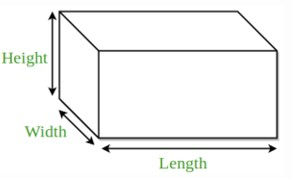如何在 Golang 中求長方體的表面積和體積?
在本教程中,我們將學習 Golang 程式,用於計算長方體的表面積和體積。面積是指任何封閉圖形所覆蓋的總空間。體積是指容器內部容納東西的能力。

公式
l - 長方體的長度
h - 長方體的高度
w - 長方體的寬度。
長方體的表面積 - 2*l*w + 2*w*h + 2*l*h
例如,長方體的長度為 10 釐米,高度為 5 釐米,寬度為 8 釐米,則長方體的表面積為 -
l = 10 cm
h = 5 cm
w = 4 cm
面積 = 2*l*w + 2*w*h + 2*l*h
= 2*10*4 + 2*4*5 + 2*5*10
= 80 + 40 + 100
= 220 cm^2
長方體的體積 - l * b * h
例如,長方體的長度為 10 釐米,高度為 5 釐米,寬度為 8 釐米,則長方體的體積為 -
l = 10 cm
h = 5 cm
w = 4 cm
體積 = l * b * h
= 10 * 5 * 4
= 200
演算法
步驟 1 - 宣告用於長度、寬度、高度、體積和麵積的 float64 資料型別變數。
步驟 2 - 初始化變數。
步驟 3 - 使用上述公式在函式中計算表面積和體積。
步驟 4 - 列印結果。
示例
在此示例中,我們將透過函式計算長方體的表面積和體積。
package main
// fmt package provides the function to print anything
import (
"fmt"
)
func main() {
// declaring the floating variables using the var keyword for
// storing the length of the parallel sides of the Cuboid,
// distance between the parallel sides and also a variable area
// to store Area
var l, w, h, surfaceArea, volume float64
fmt.Println("Program to find the Surface Area and volume of a Cuboid.")
// initializing the length of a Cuboid
l = 10
// initializing the width of a Cuboid
w = 8
// initializing the height of a Cuboid
h = 4
// finding the surface Area of a Cuboid
surfaceArea = 2*l*w + 2*w*h + 2*l*h
// finding the volume of a Cuboid
volume = l * w * h
// printing the result
fmt.Println("The Surface Area of a Cuboid whose length , width, and height are", l, ",", w, ",", h, "is", surfaceArea, "cm * cm.")
fmt.Println("The volume of a Cuboid whose length , width, and height are", l, ",", w, ",", h, "is", volume, "cm * cm * cm.")
fmt.Println("(Finding the Surface Area and volume of a Cuboid within the function)")
}
輸出
Program to find the Surface Area and volume of a Cuboid. The Surface Area of a Cuboid whose length , width, and height are 10 , 8 , 4 is 304 cm * cm. The volume of a Cuboid whose length , width, and height are 10 , 8 , 4 is 320 cm * cm * cm. (Finding the Surface Area and volume of a Cuboid within the function)
演算法
步驟 1 - 宣告用於長度、寬度、高度、體積和麵積的 float64 資料型別變數。
步驟 2 - 初始化變數。
步驟 3 - 使用長方體的長度、寬度和高度作為引數呼叫函式,並將函式返回的面積儲存起來。
步驟 4 - 使用長方體的長度、寬度和高度作為引數呼叫函式,並將函式返回的體積儲存起來。
步驟 5 - 列印結果。
示例
在此示例中,我們將透過定義單獨的函式來計算長方體的面積。
package main
// fmt package provides the function to print anything
import (
"fmt"
)
// in this line we have declared the function that has float64
// type parameter and float64 type returntype
func areaOfCuboid(l, w, h float64) float64 {
// returning the area by applying the formula
return 2*l*w + 2*w*h + 2*l*h
}
// in this line we have declared the function that has float64
// type parameter and float64 type returntype
func volumeOfCuboid(l, w, h float64) float64 {
// returning the volume by applying the formula
return l * w * h
}
func main() {
// declaring the floating variables using the var keyword for
// storing the length of the parallel sides of the Cuboid,
// distance between the parallel sides and also a variable area
// to store Area
var l, w, h, surfaceArea, volume float64
fmt.Println("Program to find the Surface Area and volume of a Cuboid.")
// initializing the length of a Cuboid
l = 10
// initializing the width of a Cuboid
w = 8
// initializing the height of a Cuboid
h = 4
// finding the surface Area of a Cuboid by calling the function
surfaceArea = areaOfCuboid(l, w, h)
// finding the volume of a Cuboid
volume = volumeOfCuboid(l, w, h)
// printing the result
fmt.Println("The Surface Area of a Cuboid whose length , width, and height are", l, ",", w, ",", h, "is", surfaceArea, "cm * cm.")
fmt.Println("The volume of a Cuboid whose length , width, and height are", l, ",", w, ",", h, "is", volume, "cm * cm * cm.")
fmt.Println("(Finding the Surface Area and volume of a Cuboid in the seperate function)")
}
輸出
Program to find the Surface Area and volume of a Cuboid. The Surface Area of a Cuboid whose length , width, and height are 10 , 8 , 4 is 304 cm * cm. The volume of a Cuboid whose length , width, and height are 10 , 8 , 4 is 320 cm * cm * cm. (Finding the Surface Area and volume of a Cuboid in the seperate function)
結論
以上是兩種在 Golang 中計算長方體面積和體積的方法。從模組化和程式碼重用性的角度來看,第二種方法更好,因為我們可以在專案的任何地方呼叫該函式。要了解更多關於 Go 的知識,您可以瀏覽這些 教程。


 資料結構
資料結構 網路
網路 關係資料庫管理系統
關係資料庫管理系統 作業系統
作業系統 Java
Java iOS
iOS HTML
HTML CSS
CSS Android
Android Python
Python C 語言程式設計
C 語言程式設計 C++
C++ C#
C# MongoDB
MongoDB MySQL
MySQL Javascript
Javascript PHP
PHP